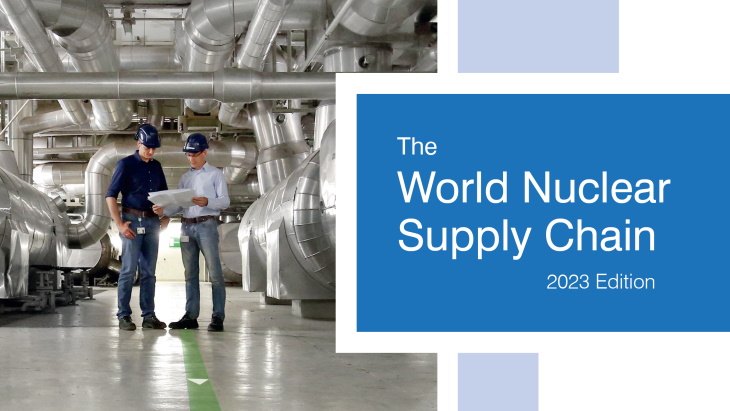The association's World Nuclear Supply Chain 2023 covers the life cycle of nuclear power plants through construction, operation and decommissioning. In addition to the current status of the supply chain, the report looks at its prospects out to 2040 and beyond.
The report notes that, at the end of 2022, there were 437 operable power reactors worldwide with a combined generating capacity of 394 GWe. A further 60 units were under construction, while over 400 more units were at various stages of planning.
Under one scenario in its 2021 Nuclear Fuel Report, World Nuclear Association projects that nuclear generation capacity could reach as much as 839 GWe by 2040.
"The capital expenditure required to build the new reactors to reach this level of nuclear capacity is of the order of USD900 billion to USD1.8 trillion, depending on whether the series effect and cost optimisation from 'nth-of-a-kind' (NOAK) builds are realised," the report says.
Meanwhile, more than 140 existing reactors could be subject to extended operation in the period to 2040. The total value of this work could exceed USD50-100 billion and involve international procurement worth around USD3-4 billion per year, the report estimates.
In addition, the decommissioning and waste management market is annually valued at USD6-10 billion.
"Consistent policies to incentivise investment are needed to ensure that a fast global nuclear expansion can be supported by the nuclear supply chain, without bottlenecks, and build in resilience against potential supply chain shocks," according to World Nuclear Association. "Unlocking the potential of enabling technologies and industrial innovation within the supply chain will be a factor in the nuclear industry's success over the coming years."
The report makes a number of recommendations to optimise the supply chain, including: lowering the cost of the procurement process by strengthening the relationship with suppliers, and employing new business and financing models; lowering the cost of components by using strategic procurement methods, optimising the use of commercial off-the-shelf components and commercial grade dedication, and using innovative manufacturing and construction techniques in nuclear plant deployment; and reducing the procurement requirements through long-term operation and optimised management of existing plants, repurposing existing infrastructure for new build (such as using coal-fired plant sites and associated infrastructure), and simplifying plant design and operation.
"Since the publication of the previous edition of the report, the outlook for nuclear power has significantly improved," said World Nuclear Association Director General Sama Bilbao y León. "An increasing number of governments are recognising that nuclear energy offers a solution to achieving net-zero greenhouse gas emissions targets, reliably and cost-effectively.
"Furthermore, concerns about the cost and reliability of gas supplies, exacerbated by the war in Ukraine, have focused global attention on the importance of energy security and sovereignty, areas where nuclear power also offers advantages.
"The ability of the nuclear industry to seize the opportunities of the current energy challenges will depend on several factors, including the capacity of the industry to build and equip hundreds, and potentially thousands, of nuclear power plants efficiently."
Members of World Nuclear Association can download a free copy of the report here.






_91467.jpg)
_47120.jpg)
_16439.jpg)





